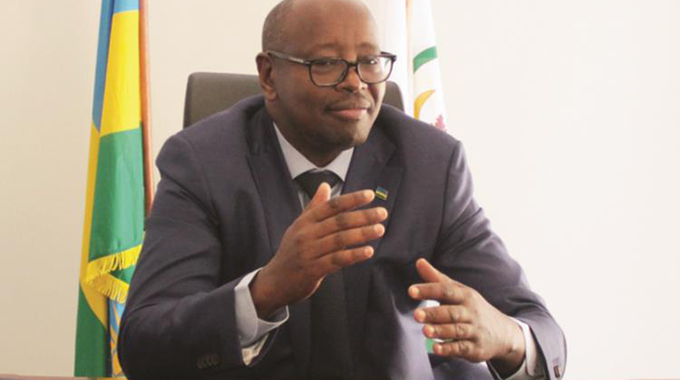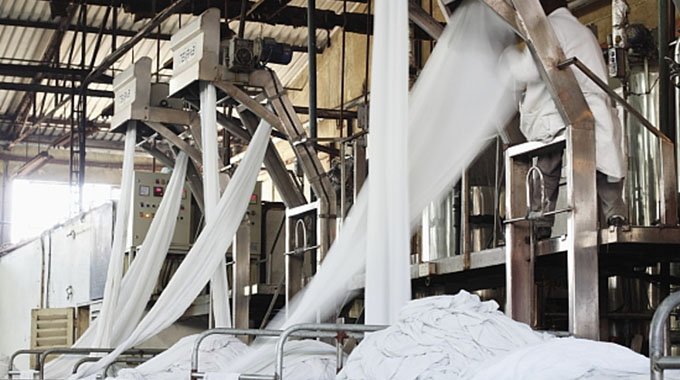Rwanda reflects on its journey

THE INTERVIEW Ruth Butaumocho
Rwanda celebrated its independence on July 1, 2019 and today (Thursday July 4) the country commemorates Liberation Day. The Rwanda Patriotic Front, led by President Paul Kagame, liberated Rwanda on July 4 and ended the genocide against the Tutsi, which was being carried out by a despotic government.
About one million people were killed during the one hundred days of bloodletting. The country was devastated and reduced to rubble. However 25 years, on Rwanda has risen to become one of the fastest growing countries in Africa. The Herald Managing Editor Ruth Butaumocho (RB) caught up with Rwanda’s Ambassador to Zimbabwe James Musoni (JM) to discuss various pertinent issues, looking at how Rwanda has managed to rise from the ashes to become one of the best emerging economies in Africa.
RB: It is now 25 years since the Rwanda Patriotic Front took over leadership of the country. What were the objectives of the struggle?
JM: After Rwanda gained its independence in 1962, the regimes that took power up to 1994 decided to carry on the segregation legacy of the colonial masters and the problems were compounded further. Those regimes were characterised by propagating hatred among Rwandans; exclusion of some Rwandans, especially Tutsis in school, work and politics; oppression of fellow Rwandans, destroying and burning their homes, killing them and sending them into exile, even culminating into the 1994 Genocide against the Tutsi and with no democratic governance.
It was a one party system. There was no effective economic agenda for the development of Rwanda, leaving the Rwandan people in poverty, disease, ignorance and dependence on foreign aid. There were also high levels of corruption.
The RPF-Inkotanyi was formed with the objective of liberating Rwanda from the dictatorial regime in order to build a nation that abides by law and uphold democracy, peace, security, justice, fight corruption, social economic development, and eliminating all causes for fleeing the country and returning all Rwandan refugees back into the country.
RB: How was the situation in Rwanda in 1994?
JM:The genocide against the Tutsi in 1994 left a million dead, many others injured and brutalised. The country was traumatised and shocked by the scale of the violence. Over three million Rwandans fled to neighbouring countries. Rwanda’s economy shrank by 50 percent and GDP Per capita fell to $146 — a 20-year low while inflation was at 68 percent, with poverty rates hovering at 78 percent. The infrastructure was completely dilapidated.
There was a huge skills gap with 79 percent of civil servants having no higher education qualifications.
RB: What approach did the government in Rwanda took under these difficult circumstances?
JM: The first thing that was done after driving the genocidal forces out was to establish a government of national unity to foster peace, reconciliation and restoring peace and security.
The other priority was the repatriation of refugees and the resettlement of internally displaced people. Emergency relief and social assistance to genocide victims and vulnerable persons was another priority as well as the rehabilitation of basic infrastructure. Setting up key institutions and public service at central and district level was also high on the agenda and restarting of basic services such as health and education.
RB: What progress have you made in terms of reconciliation?
JM: We came up with home-grown solutions which dispensed restorative justice because in most cases perpetrators and victims were either neighbours, relatives or people that knew each other. To create harmony and reconciliation, we had to resort to a restorative justice system such as the Gacaca Courts.
As a result of reconciliation measures put in place, several millions of refugees have returned to Rwanda to rebuilt their lives and also participate in the economic reconstruction. Senior members of the former army, who did not play a role in the genocide against the Tutsi, have freely come back to the country and even joined the new national army, the Rwanda Defence Forces. Some even hold very senior posts in the army, government and the private sector. Several thousand combatants from the former regime army repatriated and voluntarily integrated into society.
RB: Given this situation, how is Rwanda today?
JM: I am happy to say that Rwanda is fast growing. It has the second fastest growing economy in Africa at per annum since 2007.
Rwanda is the most improved nation in human development in the world. It has a young and growing population (70 percent of population under 30). It has low risk as it is the fifth safest country to walk at night worldwide.
Rwanda has the lowest debt ratio in region and stable credit ratings. The country’s currency is stable against the greenback and other major currencies in the world. Rwanda is well-governed and has a business-friendly environment.
It is ranked number two in Africa for the ease of doing business and it is ranked number one for government transparency in Africa. Rwanda has the biggest number of women in Parliament and in a gender-balanced cabinet in the world at 61 percent and 50 percent, respectively.
The country is a regional platform with a strong African hub potential with its highly connected African airline. The country is on the third position in hosting high level conferences in Africa. Rwanda has a growing bilingual, educated workforce with 50 thousand tertiary graduates a year.
It is alive to the global information technological initiatives, making it one of the fast-paced nations in world for network readiness. The country is second in the world for ICT promotion with 95 percent 4G LTE network coverage and a 7 000km fibre.
RB: With all this progress Rwanda still has refugees like here in Zimbabwe. What plans do you have to have the refugees repatriated home?
JM: After the genocidal army and its militias were driven out in July 1994, there was a wave of refugees leaving the country mainly because they were unsure of what the future was holding for them.
Close to four million Rwandese left the country and settled mainly in neighbouring countries.
But when they realised that the government of Rwanda was pursuing policies of unity and reconciliation as well as specific programmes to encourage voluntary repatriation of refugees, up to 3,5 million returned to their homes.
We, therefore, encourage refugees, especially those who live in Zimbabwe to work with the Government of Zimbabwe, UNHCR and the Rwandan government to obtain proper documents. The embassy of Rwanda in Harare will work with other partners to facilitate that. You will be aware that the United Nations High Commissioner for Refugees evoked the cessation clause for Rwandans who fled the country between 1959 and 1998. What this means is that Rwanda was declared peaceful and safe for all refugees to return home.
The cessation clause came into effect on January 1, 2018 and hence nullified the refugee status for them because there is no well-founded fear of persecution in their home country. It means they are left with two options of either repatriation or naturalisation as citizens of the host countries. In some instances, refugees are not repatriating due to misinformation from those who want to hide under the cover of propaganda and lies.
RB: There are allegations that the government of Rwanda is pursuing and persecuting refugees. How far true is this?
JM: It is not true. This is propaganda by negative groups that want to cover up on their negative and criminal activities against Rwanda. Some of the refugees have criminal records back home and they are trying to evade justice by creating impressions that they are under persecution. Rwanda is a signatory to international conventions and we do respect these conventions that protect the rights of refugees. Rwanda is a signatory of the 1951 Refugee Convention.
RB: Rwanda has become a model of socio economic development in just a few years after the RPF took over the country. What are the drivers?
JM: Indeed, that is a fact. His Excellency President Paul Kagame came up with three fundamental choices: national unity, accountability and thinking big.
Accountability is hinged on performance contracts (imihigo). There are performance contracts signed with the President of the Republic at all levels of government. This is aimed at cascading national priorities into institutional key performance indicators. This ensures external empirical assessment of performance against key performance indicators and recognition of good performance and accountability for poor performance. Then, there is the National Leadership Retreat (Umwiherero), an annual gathering of over 200 leaders, including the Rwanda’s ambassadors. This is a platform for candid discussions on implementation progress of agreed national priorities and open discussions on addressing challenges. Another platform is the National Dialogue (Umushyikirano,) a broad range of stakeholders — government, private sector, non-governmental organisations, developmental partners and citizens. This is a platform that encourages participatory democracy — exchange of ideas, lessons and holding leaders accountable for delivery.
The Thinking Big concept is aimed at making Rwanda a middle income economy by 2020. This is riding on the successes of the post-conflict reconstruction period, high economic growth rates — average growth is eight percent, significant poverty reduction, building strong and solid institutions and private sector led development.
Vision 2050 is envisaged to ensure that Rwanda becomes a high income economy by 2050. Under this vision, Rwanda is aiming at extremely ambitious growth rates of 12 percent annually between 2025 and 2035. Under Vision 2050, economic growth needs to establish Rwanda as a globally competitive, knowledge-based economy.
There are also medium term-five year cycles with clear and measurable targets. For example we intend to ensure that 214 000 jobs have to be created annually, private investments should grow to 21,2 percent of GDP and a 17 percent annual growth in high value exports.
RB: Lastly, what are the areas of cooperation between Rwanda and Zimbabwe that you are currently pursuing?
JM: The establishment of the embassies of the Republic of Rwanda in Harare this year and of the Republic of Zimbabwe in Kigali is a testimony to our good relations. Rwanda and Zimbabwe share a similar history of oppression, and liberation struggle. Our Presidents also share the same vision of Pan-Africanism. His Excellency President Kagame supports the Government of Zimbabwe’s effort to have sanctions imposed on Zimbabwe removed so that Zimbabweans can be allowed to realise their aspirations.
In terms of economic cooperation, Rwandair, our national airline, makes direct flights between Harare and Kigali. We want to take this relationship to higher levels by encouraging and facilitating movement of investors from both countries as well as exchange of experience and technical assistance between government institutions.
For feedback:[email protected]









Comments